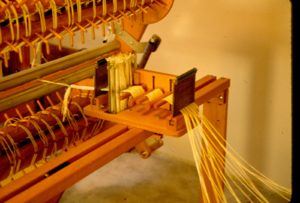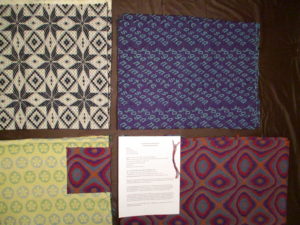For many of us, staying home has meant digging in to our crafts and dwelling in our work space. To keep us connected during the pandemic, WGM members and those beyond the Guild who inspire us are welcoming us into their studios. This week, we’re taking a peek into the studio of WGM member, Linda Madden.
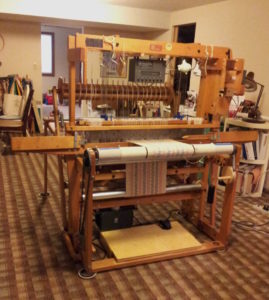
WGM: Please tell us about yourself and introduce your practice:
LM: I am a weaver and have been a student and teacher of weaving at the Weavers Guild of Minnesota. In the late ‘70’s and early 80’s I was a production weaver selling my work at art fairs and consignment shops. I specialized in table linens and simple garments.
These days I primarily weave as part of two study groups affiliated with Complex Weavers. In these groups we study a structure and weave an original design and exchange documentation and swatches with all members of the group yearly. My groups are Tied Weave and the Sixteens. Tied Weaves are for tied weaves and related weaves. The Sixteens study a different sixteen shaft structures each year. This year it is Satin. Above you can see some of the cloths developed for the study groups and a sample and documentation for one of them. It is a Four Color Double Weave that I was very happy with.
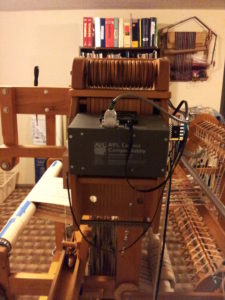 WGM: Tell us about your space?
WGM: Tell us about your space?
LM: My space is a large room in my basement. This room was one of the reasons we bought this house over twenty years ago. It is great to have a place that can contain all my weaving equipment, sewing machine, serger, work table, ironing board, books and magazines and paraphernalia in one place.
My primary loom is a 16 shaft AVL dobby loom which I bought new for production weaving in 1983. It has two sectional back beams, an automatic advance system and fly shuttle. It began as a mechanical dobby with dobby bars and pegs but was upgraded to a computer drive (Compu-Dobby) later. That really expanded my design capabilities. An e-lift system was added after my first knee replacement. This system uses a foot pedal to lift the shafts and advance to the next pick with just a tap of a toe. This made it possible for me to continue weaving.
WGM: What is your favorite tool?
LM: My warping system has evolved from warping boards to sectional warping to the use of an AVL Warping Wheel. Sectional warping was very efficient when I was weaving long warps for production weaving. Later when I was not weaving for sale, the AVL Warping Wheel came along. It allowed me to continue sectional warping without filling multiple spools and purchasing many cones of yarn. It was such a great simplification of my warping process. The only teaching I do these days is a short lecture/demonstration class on sectional warping and use of the warping wheel.
WGM: What is your design process?
LM: My process for designing a warp usually starts with study of the structure. I have complete sets of Handwoven Magazine and Weavers Magazine and library of most of the basic weaving texts.
Sometimes my study group chooses a structure that is new to the literature and I purchase new books. (Weaving With Echo and Iris was one that I love.) Once I get a handle on the structure I check my yarn supply to see what I have that would work and sometimes it requires purchase of yarn.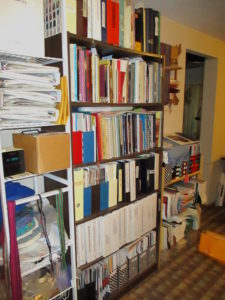
I have a lot of yarn from the days when I bought yarn in bulk for production weaving. Then I calculate how much yardage I need for my exchange samples for the study group and add additional yardage for my own use. Determining sett is always a challenge. I allow yardage for sampling of wefts and to check sett. I call this “auditioning wefts.” I often find the need to change setts. Below is a way I have found to change reeds.
Switching reeds: 1. Treadle tabby and insert a lease stick in the shed BEHIND the reed. 2. Treadle opposite tabby and insert a second lease stick BEHIND the reed. 3. Hang the lease sticks from the castle and tie the ends together. 4. Leaving enough space cut the warp at the end of your sampling. 5. Pull the cut ends out of reed. 6. Move beater out of the way. 7. Hang a new reed horizontally from the beater and begin to dent the reed from the order held in the lease sticks.

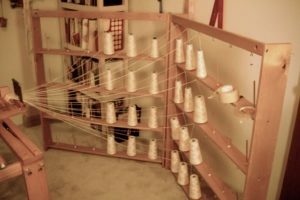 .
. 